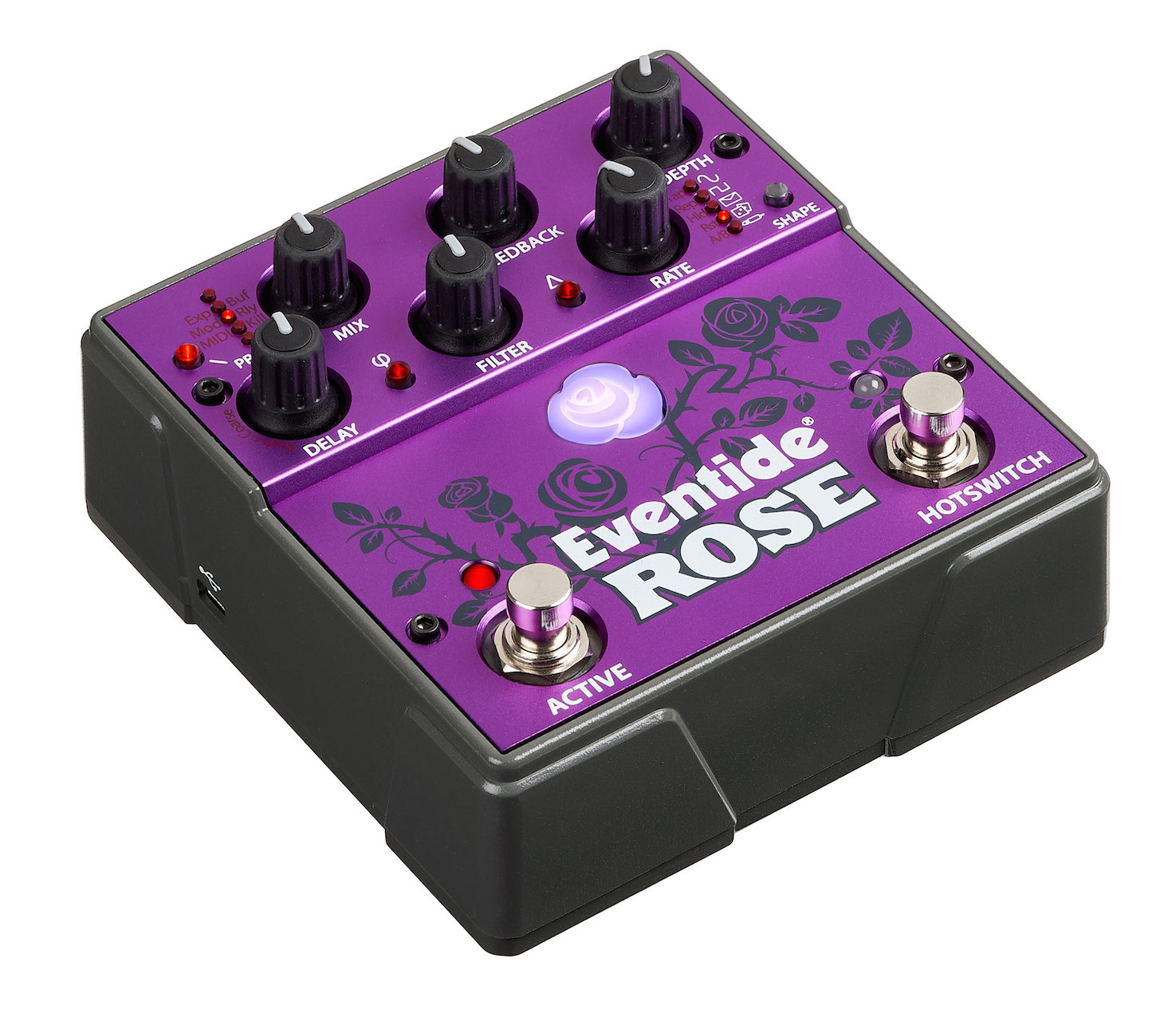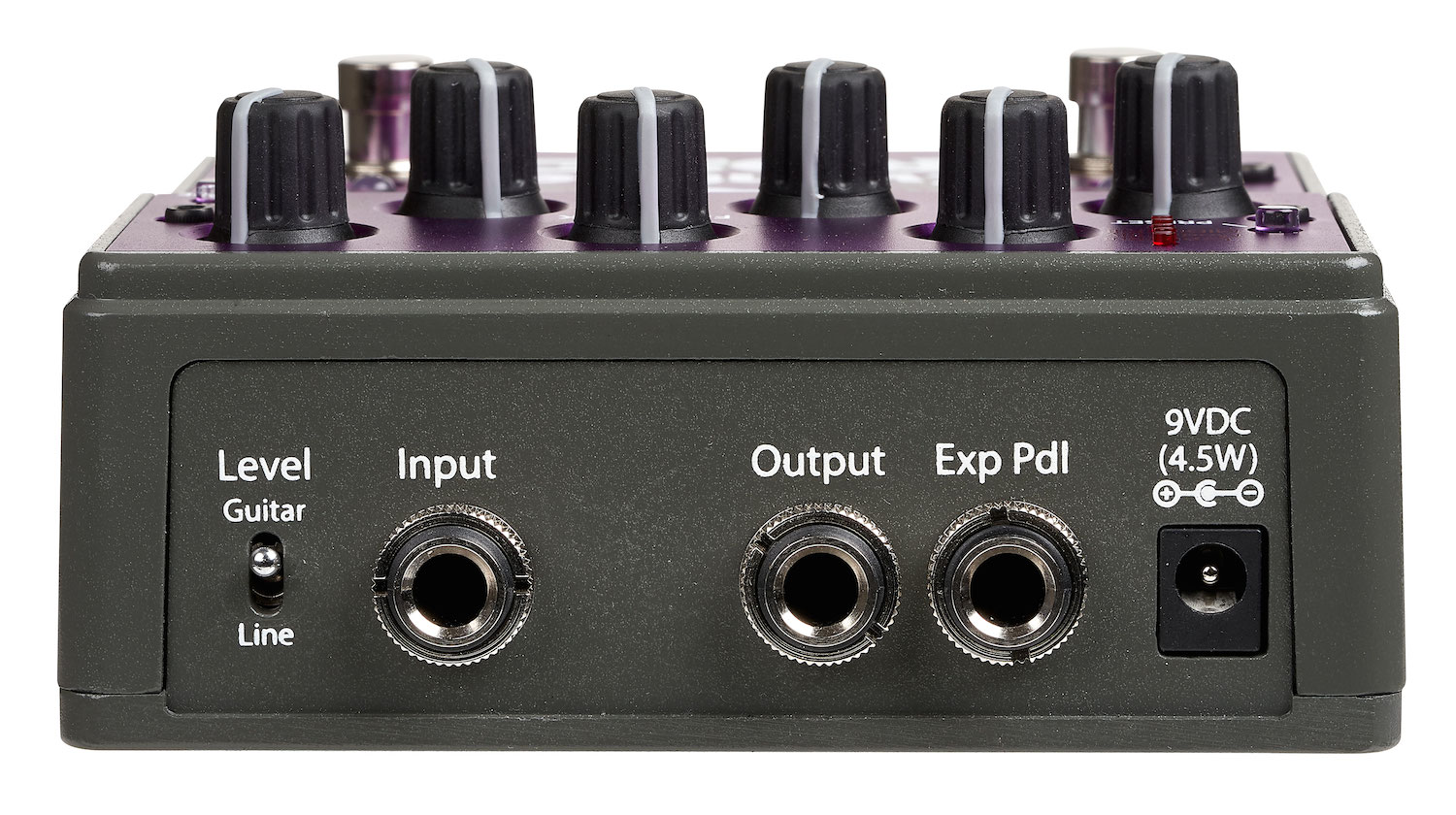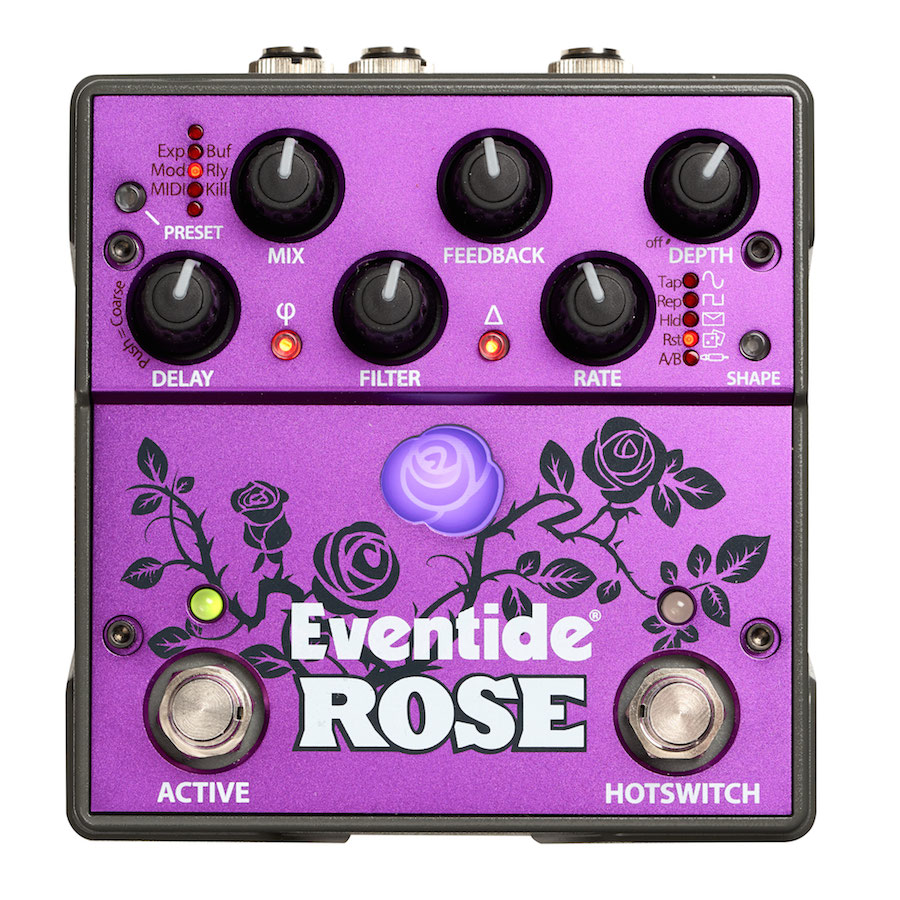New Gear Review: Rose Delay Pedal by Eventide

Their first single-effect unit in years, Eventide’s Rose delay pedal comes highly anticipated—can it find a home on your pedalboard?
The New Jersey-based digital audio pioneers at Eventide have long been known for creating game-changing studio multi-effects units like the highly lauded H9000, and more recently, for their extensive and growing line of plugins.
Over the last decade-plus, Eventide has also become a serious player in the pedal game, and today the company is known just as well by touring musicians as studio pros.
Eventide’s TimeFactor pedal, released all the way back in 2008, is often heralded as one of the most flexible delays in stompbox form, ever. With stereo audio connections, MIDI inputs and outputs, aux switch and expression pedal control paired with nine delay types and a looper, it’s no surprise the TimeFactor has been seen on pedalboards of countless professional musicians worldwide.
Now, Eventide has announced a new delay pedal with a smaller footprint, called the Rose, that is said to be “the culmination of five years of R&D harkening back to the 1745 DDL, the original Digital Delay Line.”
Given that this is Eventide’s first single-effect unit in many years, those who appreciate the brand’s crisp sonic signature are excited. And they should be, as the Rose features a clean, modulated delay with the ability to save five presets, an analog low-pass filter, and a host of other sound-sculpting options that show Eventide’s time has been put to good use.
Features
The front panel of the Rose features six knobs, two footswitches, and four buttons. You’ll immediately notice the bright purple color scheme and the intricate Rose design on the pedal, which seems to elicit a “love it or hate it” reaction. The back of the pedal features a power supply input, a mono input with the option to set it for instrument or line level, a mono output, an expression pedal jack, and a micro-USB port.
The USB connection on the Rose allows for software updates as well as giving access to a future preset manager, which was not yet available at the time of this review. Interestingly, MIDI over TRS into the expression pedal jack is also available using a kit like the Disaster Area Designs MIDIBox. And with the recent v3.04 Public Beta Release (included in the Eventide Direct Updater), it is now possible to use MIDI clock over USB with the Rose.
25 presets are available to be stored (five banks of five), with A and B settings for each. These are accessed two ways: by pushing the small Preset button in the top left corner (which is admittedly a bit tough to reach), or by hitting both footswitches at once and using the right footswitch to scroll between them. You then load the preset by pressing the left footswitch.
The Rose utilizes both digital and analog components, though the technology that went into the pedal is totally different from the DSP-based processing of the older TimeFactor. Here, the delay timing is generated by a digital clock, and has a range between 10 microseconds and 10 seconds. Using the Delay Multiplier button on the front panel multiplies the delay setting by 2x, 3x, 4x, or 5x, making a maximum delay time of 50 seconds possible. This is a massive time range and really makes using the Rose incredibly flexible for a variety of delay needs, from slap-back sounds to long and lush repeats.
The Delay knob has the ability to set both coarse and fine timing separately. Pushing down on the knob and turning selects a coarse time range, from comb-filter fast to slow and dubby. Once the range is set, turning the knob without pushing sets the finer delay time.
The front panel also boasts a ”Phi” button that flips the phase when the delay setting is under 20 milliseconds, or reverses the delay at longer delay time settings. The reverse setting sounds quite lovely and greatly expands the palette of sounds available from the Rose, especially when combined with modulation.
Speaking of modulation, the modulation in the Rose is one of its most unique qualities. There are five shapes available, which can be scrolled through with a dedicated button. Each modulation source has a small but clever visual icon on the front panel, as well as a specific color glow in the rose on the front of the pedal. In the dark, this makes using the Rose a delight.
Sine, square wave, envelope follower (denoted by a literal envelope icon), random (denoted by a dice icon), and external options are available. Setting the modulation source to external allows the Rate knob to control the modulation speed directly, or to have the rate of modulation set through the expression pedal. Modulation can effect pitch up to a full octave range in either direction, so there’s quite a bit of wobble to be explored.
The envelope follower mode allows for a lot of unique sounds that are not normally available from a delay pedal. For example, hitting the Rose with a louder input makes the modulation depth greater, and thus alters the pitch of the delay repeats more. This alone adds a lot of utility to how the Rose could be creatively integrated into your rig, especially considering it takes line level input with the flip of a switch.
The right footswitch is a hotswitch that offers several functions depending on the mode it has been set to. It can be used to tap tempo, trigger an infinite repeat setting (over which the regular delay is still heard), set modulation to hold, reset the modulation cycle, select between the preset’s A and B options, and to select Phi or Delta. Holding down the Shape button, followed by pushing it again to scroll, accesses these options. The tap tempo function has the extra ability of affecting either the delay time or the modulation speed.
Eventide have also offered three options for how the pedal works when bypassed, allowing those repeats to ring out if so desired.
In Use
Clearly there’s a lot of flexibility and scope with the range of variables the Rose offers. Given the huge delay range, the wealth of modulation sources, the analog filter, and the delay multiplier function, it’s no surprise that there are many, many sounds that can be summoned from the Rose.
Chorus warble, a very suitable Leslie emulation, swishy slap-back delays, dark psychedelic washes, reversed delays, and weathered analog-like repeats are all quickly programmable. Using the Rose’s ability to store presets means it’s painless to recall these settings, and furthermore, it’s possible to use the expression pedal to morph between the A and B settings for each preset, which is nice for adding another element of sonic movement.

The Rose conveniently features a switch for line level input on its back panel—perfect for use in the studio.
Despite the pedal’s unique analog/digital architecture, changing the delay time alters the pitch of the repeats as you’d expect with any analog pedal, and Eventide have made sure to keep the signal as clean as possible. Without any of the filter or modulation applied, the Rose functions well as a sparkly digital delay. However, crank the modulation depth with the Random source chosen and apply the low-pass filter, and you’re suddenly in much swampier territory that would be as suitable for psychedelic workouts as it would for indie rock.
Because of the mono signal path, it’s important to note that some of the stereo delay options from the TimeFactor are not able to be recreated here; in fact, the Rose does away with the modeling approach of the TimeFactor altogether.
Five demo units of the Rose were given to guitarists while the pedal was in production, and their feedback was taken into account with the final design. The resulting playability is high, given that there are six knobs to tweak, a hotswitch with variable modes, flexible expression pedal control, and feedback that goes into oscillation with just the right amount of nudging. Throw just about any sound source into the Rose and it’ll morph into a repeating storm of feedback with the flick of a knob.
To Be Critical
Despite the fact that the Rose was hard to turn off at times, there were a few niggles I had with the pedal. The many functions of the Rose meant that the faceplate design is a bit crowded, and learning the workflow of the pedal did require a bit of diving into the manual.
Secondary functions of the buttons are a bit hard to read legibly given the small text on the front of the panel, but this is a trade-off of having a smaller footprint. The Factor series of pedals were quite large, so the smaller size of the Rose is going to be very welcome to many. The knobs themselves are of high quality, though I did find them to have a bit more resistance than I would have liked.
While I didn’t mind its bright coloring, the design of the Rose might be a thorn for some. The bright purple certainly makes it stand out on a crowded pedalboard.
Summing it Up
Despite the fact that the Rose is an all-new design, it’s hard to not compare it to the TimeFactor. That pedal’s dual-delay format, along with a plethora of control and connectivity, made it a coveted pedal for sonic spelunkers of many genres. Eventide has clearly chosen a simpler path with the DDL-based Rose, while still offering a lot of depth for those who want to dive deeper. It’s worth mentioning that many of the functions have CC control assigned as well, making it possible to automate the Rose in your DAW.
In a few ways, the Rose is more similar to Eventide’s Eurorack delay offering, the EuroDDL, which also has the delay knob with push-and-turn functionality, the low-pass filter, and clock multiply options. Unsurprisingly given the connectivity inherent in the Eurorack format, the EuroDDL has more connections, as well as a knob dedicated to controlling a filter drive, which is missing from the Rose.
However, Eventide have really spent their time wisely with the Rose. It’s an incredible sounding delay pedal that produces a wealth of tones, from clean and straight to dirty and off-kilter. The fact that there’s no DSP at all makes it an even more impressive feat of design. At $349 USD, it’s certainly an investment, but for those looking for a pedal that can also function as a worthy studio tool and a pedalboard mainstay, Eventide’s Rose might just fit the bill perfectly.
Leo Maymind is a producer, DJ, and writer living in Los Angeles, CA. He is obsessed with sound, and you can reach him at lmaymind@gmail.com.
Please note: When you buy products through links on this page, we may earn an affiliate commission.







